Dreamtime in Nature – The Beauty and Love of the Natural World
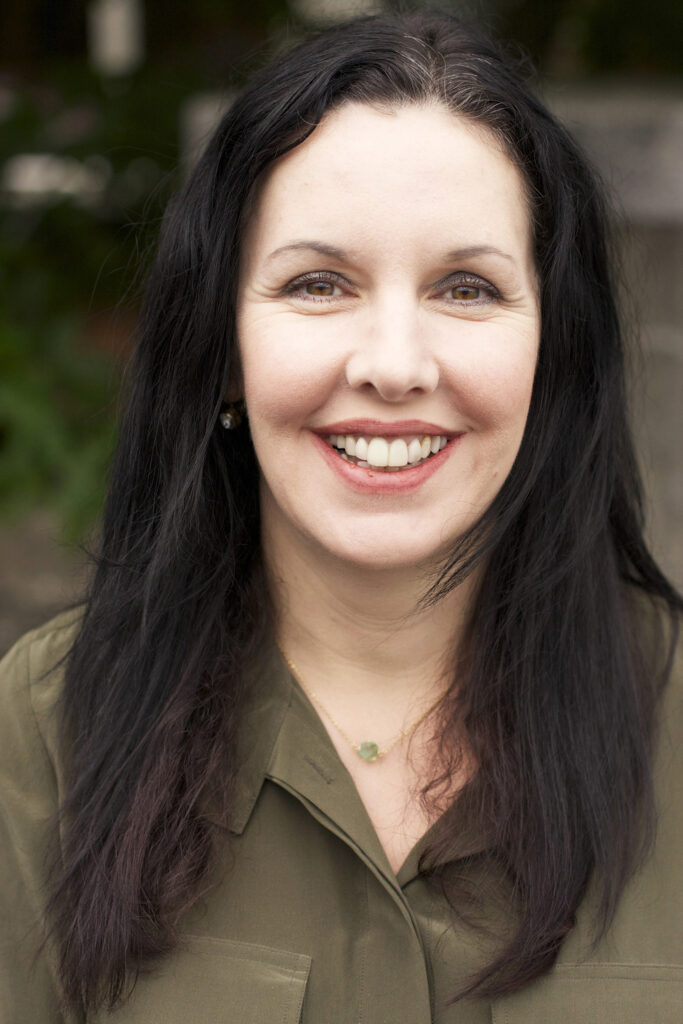
THE TAKEOVER
I am delighted to be asked to do the Greenhouse Culture
Takeover which provides a space for green thinkers to
invade and occupy.
I intend to use the space to share my artworks, musings
and inspirations on the beauty and power of nature and
the natural world that surrounds us and to invite friends
to join me and share some of their own thoughts and
images.
Artworks by Mary Moynihan
I am displaying three poems.
The first is ‘In Time’, a poem film written and created as a personal response to the changing landscape of our world today in a time of pandemic and is my dream for the future’. The poem was transformed into a poem film, co-directed with Mark Quinn, performed by Carla Ryan and Kwasie Boyce with original music composed and performed by Lisa McLoughlin-Gnemmi.
‘In Time’ was presented as part of the Emotional Landscapes exhibition in the Dublin Arts and Human Rights Festival 2020.

In Time by Mary Moynihan
Secondly, I wrote ‘On the Ledge of Courage’ during a time of darkness in my life and the danger of death was present. I needed a way through the darkness and wrote the poem as an acknowledgement of the beauty and preciousness of life and in particular to honour the ways that ordinary people reach out and help each other. It was during the Covid pandemic at a time when we saw and heard countless stories of acts of kindness and care. Fear and courage can live within us at the same time in the same way that we can have strength in our vulnerability. The physical ledge referred to in the poem was inspired by the Great Skellig or Skellig Michael (Sceilg Mhichíl) overlooking the vast Atlantic ocean, a wonder of nature and the natural world. But this ‘ledge’ is in all of us and we often have to let ourselves dive off the ledge into the unknown for both ourselves and others.
The Great Skellig is a steep island shooting straight up two hundred metres out of the cold Atlantic ocean, standing aloof like a majestic stone palace that can be seen for miles around. I often find myself thinking about the Great Skellig, the way it stands alone in the middle of the vast ocean, tall, silent and rooted, whether the seas around it are calm or stormy. Life is the same, some days will be calm and others stormy, but to remember that the storms shall pass.
The third poem ‘Meadow Woman’ is a reflection on the beauty of a wildflower meadow and the nature that is both around and within us.
In Time By Mary Moynihan In time . . . In time we will recover. In time there will be a vaccine and we will be able to go outside, to work, to the park, to the mountains, to meet our family and friends, to travel to the ends of the earth if we wish. In time we will rebuild our world. We will create an equal society where people count - our family, friends and co-workers, and all those who provide services and look after each other. We will get our values right, our priorities straight and create a world for what really matters – people, the planet we live on and dignity and respect for all. In time we will meet each other in the darkness of a theatre space and know again the magic of a connection that is invisible yet truly felt. In time we shall hug those we love and have missed. In time we shall mourn and remember those who have died. In time we shall bear witness. In time we will breathe calmly again. In time we shall create and imagine what if. . . In time we shall reject governments that do not respect people or act on our behalf. In time we shall create respect for the planet we live on and know that our atmosphere is clearing up and soon the world will be able to breathe again. In time we shall be true to our inner selves, hear the inner voice of our own souls and follow our heart’s desire. In time we shall serve ourselves and equally, at the same time, serve others. In time we shall fight the good fight and at the same time, let go. In time we shall enjoy life and be present in the moment. And perhaps one day, in time, we shall realise . . . there is no time. Copyright: Mary Moynihan

On the Ledge of Courage By Mary Moynihan A poem dedicated to all those who stand up for the rights and dignity of others. How can I be there when darkness sets in, How can I love you from deep within, How can I reach you when no-one else can, How can I hold you when my courage has ran. How can I touch you when we are apart, How can I share with you all of my heart, How can I give you all that you need, How can I protect you, I hear myself plead. What if I crumble, a slave to my fears, Seeking shelter away from the wounds of your tears, The tyranny of weakness won’t let me lie In peace by your side as the hours slowly die. I cry like the birds on the cliff at the edge of the sea - Squawking at Gods to set me free, Caught between worlds in liminality While facing the abyss of eternity. On the edge of fear, I tremble On the ledge of doubt I dissemble On the ledge of my faith how far will I fall On the edge of my love will I answer your call. Shall I step backwards and let selfishness win, Crawl from my cruelty, my weakness, my sin. Or step forward in love and taste the divine - I am your God and you are mine. On the ledge of courage standing tall for thee I will fly like a bird to set you free, Plunging deep into oceans or soar to the skies To retrieve the light for the stars in your eyes. I am your breath and you are mine, I am your life to the end of time. Copywright: Mary Moynihan
Meadow Woman By Mary Moynihan I want time to swim, to fly, to be at ease, to laugh and dance and time to tease, To flirt and love, to roll and tumble, to play undisturbed and be humble - I want an age for me, hours for free and moments to simply be. To be released from the maelstrom of stormy seas, Be young again in a songbird’s meadow With a gentle breeze on a summer’s day, To gently float my tears away Amidst the blush of a joyful sway Where all is lush, calm, hazy, Only a single leaf twitters, my mood is lazy As I navigate the banks of a glistening river That gurgles, babbles, and cleanses my soul. I stroll alone, at peace in a field of buttercups and sweltering sun where time and I are one. I am home - Free at last, in palmy meanderings through waist high grass, counting bluebells with narrow leaves and drooping stems - Willow herb for my wildflower bed, A pillow of honeysuckle to rest my head. where I dream of native species that grow wild, As I am carried high on the swarming fragrance of a buzzing bee - I am the dandelion gone to seed, Caressed and pleased, A prick from the purple thistle, the softness of Queen Anne’s lace, a stroke from the devil’s paintbrush, to erase the frowns on my face. My time once threatened, declining, stained, I am possessed like a new found meadow, To be restored, maintained. No longer hanging on at the edge of town But rich with life in a pulsating gown Of butterflies, ferns and flowers. To live again my halycyon dream - I am meadow woman resplendent in a swirl of green speckled with purple, yellows, blues. I pluck sweet goldenrod and dance supreme - A maenad queen unconquerable at last Wrapped in the power of my ancient past. Copywright: Mary Moynihan
Musings
Midsummer at World’s End
Words by Mary Moynihan
Midsummer Day, also known as the Summer Solstice, is an ancient day that people around the world celebrate each year, marking the longest day and shortest night of the year. Historically the day falls on June 24 with the evening before, June 23, known as Midsummer Eve.
According to the Almanac ‘’Astronomically speaking, summer begins on the solstice. In 2022, the solstice arrives on Tuesday, June 21. At this moment, the Sun reaches its highest and northernmost points in the sky and Earth’s North Pole tilts directly toward the Sun . . .Historically, this day marks the midpoint of the growing season, halfway between planting and harvest. It is traditionally known as one of four “Quarter Days” in some cultures’.
For some, Midsummer Day marks the beginning, middle or height of summer and it is a magical time for bonfires, dancing and celebrations which begin on Midsummer Eve.
We are very lucky in Ireland to have beautiful natural landscapes and a great way to celebrate the Summer Solstice is to go out into nature. In Dublin we have the sea and mountains with walks such as Kilmashogue (linked to Ticknock) and Tibradden Wood.

A beautiful place I visited recently was the viewing rock in Carrickgollogan in the Dublin Mountains where you will discover one of the most spectacular views of south Dublin, North Wicklow and the Irish sea. There are two walking trails through the woods of Carrickgollogan. According to Coillte, the first is the Lead Mines Way which is two kilometres and is an easy 40-minute walk. It is a gentle stroll through the forest and leads you to the old lead mines chimney. The Mountain Access Route is a five-kilometre, thirty-minute moderate walk and is a linear trail that takes you to the top of Carrickgollogan hill with breath-taking views of the Dublin, Wicklow countryside and the Irish sea. This place is a hidden gem.
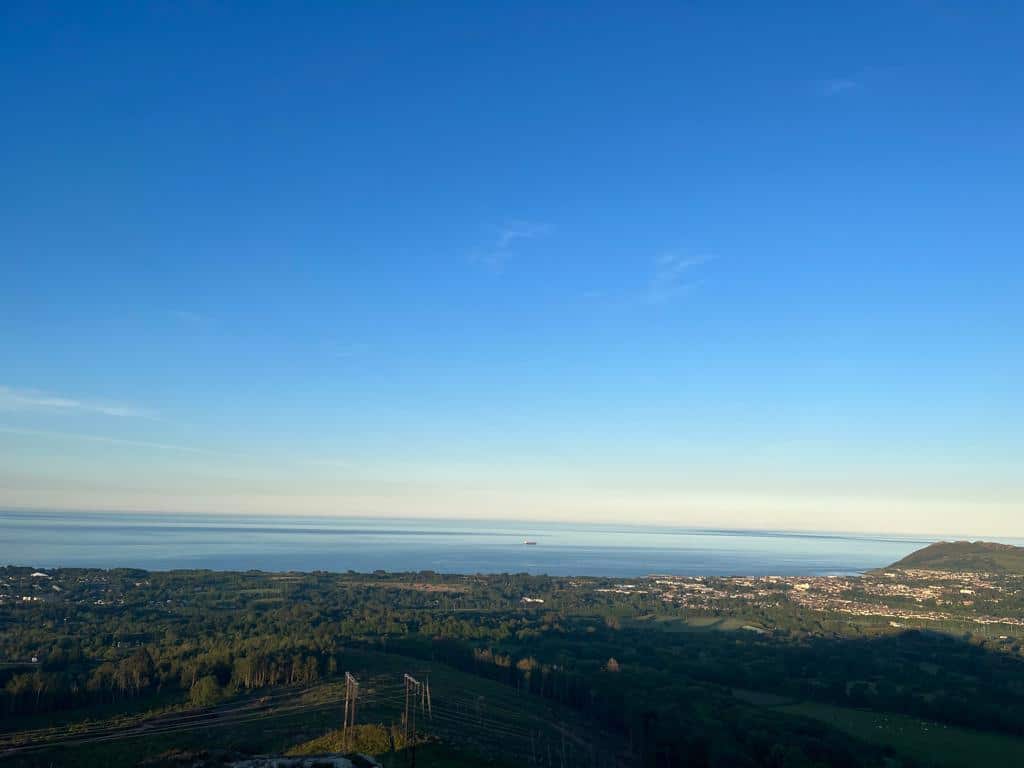
Travelling much further afield two of my favourite places of nature in the world that give me inspiration and a sense of peace and connectedness are Valentia Island and Derrynane beach, both in County Kerry, at the furthest end of Ireland, at world’s end, over two hundred miles from Dublin. Kerry has a number of beautiful peninsulas and the most southerly one is called the Iveragh Peninsula where Valentia Island and Derrynane are located.

I love going down past the towns of Killorglin, Caherciveen and Waterville, ascending the black mountains, with rocky terrain and majestic heights, to a place that echoes the words ‘sun and moon, day and night, sea and land’. Driving through the mountains on Midsummer’s Eve is a time, according to superstition when the Otherworld is close and you can see fairies especially if you’re beside a fairy ring or standing stone! Derrynane Beach is a beautiful, curved sandy beach in Derrynane Bay, close to Derrynane House which is located on the Derrynane National Historic park and is the former home of the 19th century Irish political leader Daniel O’Connell, known as the liberator. There are actually three beaches and when you get to the end of the curved bay there is a small island called Abbey Island which is accessible only when the tide is out across a sandbar. The island is filled with headstones and graves including the grave of Mary O’Connell, the wife of Daniel O’Connell and is also home to the remains of a sixth-century abbey. It is a beautiful, peaceful place to visit.
Valentia Island lies off the Iveragh peninsula and is accessible by a land bridge at one end of the island near the village of Portmagee and a ferry crossing at the other end. It is a beautiful island with fabulous nature, walks and fun stuff to do. The western part of the island offers fantastic views for walkers especially if you hike to the top of Geokaun Mountain which is the highest point of the island. For palaeontology enthusiasts, the island boasts a fossilised tetrapod track-way of more than 150 footsteps. The Valentia Island track-ways are among the oldest signs of vertebrate life on land – the first discovery of its kind in Europe. The tetrapod came ashore more than 350 to 370 million years ago.
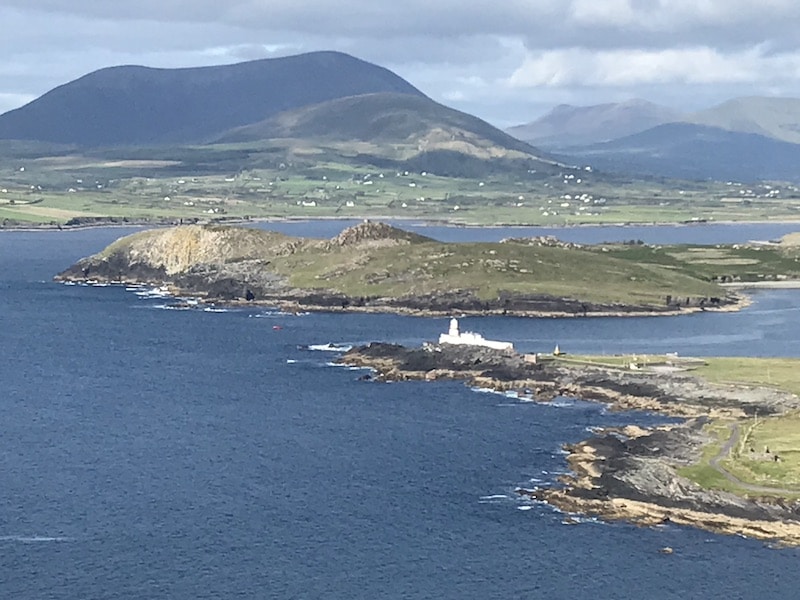
From Valentia Island, one can see the dark island of the Great Skellig looming far out to sea. As I wrote earlier, The Great Skellig is a steep island shooting straight up two hundred metres out of the cold Atlantic Ocean, standing aloof like a majestic stone palace that can be seen for miles around. Skellig Rock is about 12 nautical miles out to sea and is actually three islands, a small one called Lemon Rock, then further out is Little Michael, a bird colony with over 26,000 pairs of gannets on it. Next to that, about a mile away, is Skellig Rock itself, known as Skellig Michael or the Great Skellig. Around the sixth century Saint Fionan and twelve monks travelled out to build a remote medieval monastery high up on top of the island. They believed they could be closer to God if they lived like wild birds on narrow cliff edges in the harshest, desolate place you can imagine. But the weather was so extreme they were eventually forced back to the mainland. All that’s left out there now are the remains of their settlement perched on a ledge close to the top. Today this very early Christian Monastery has international importance as it is recognised and designated as a UNESCO World Heritage Site
There are many beautiful places of nature around us, enjoy, protect and love them as much as you can.
The Artist Speaks – Saving Our Planet
Words by Mary Moynihan
Climate activist Greta Thunberg says ‘ We are living in the beginning of a mass extinction and our climate is breaking down. But we can still fix this – you can still fix this. It’s simple. We need to protect, restore, and fund’. That means protecting tropical forests that are being cut down at the rate of 30 football pitches a minute, restoring the large areas of the planet that have been damaged and to stop funding industries that destroy nature and instead pay for activities that help and support the planet we live on.
Greta Thunberg is supporting calls for an end to state subsidies for fossil fuels. If we are to stop the world heating up by more than 1.5C we have to stop fossil fuels and keep carbon in the ground. That means no more oil or coal. We need to move away from palm oil and nuclear energy and to use solar and wind power and new green technologies and to invest in alternative, green and natural sources of energy.
Saving the planet and promoting climate change requires both personal and political action – we need individual change and support for eco-friendly environmental living plus to agitate, organise and campaign for systemic change particularly in relation to tackling large corporations on fossil fuels, palm oil and deforestation.

Taking personal responsibility for climate change is important but is not enough without political change and corporate accountability. The climate crisis requires planet-wide change therefore governments around the world have to be involved in large-scale reform, implementing legislation to ensure giant industries act sustainably and, where appropriate, play their dues for damage caused to date or into the future.
According to the Mary Robinson Foundation for Climate Justice, key principles of climate justice include putting a respect for human rights, equality and justice at the heart of climate action. The aim is to take a science-focused approach while linking climate justice to human rights and development in order ‘to achieve human-centred approach’. This means that giant fossil fuel corporations and other industrial entities who have played a part in fuelling the crisis to date must be held accountable into the future. According to the Carbon Majors Report.
100 producers account for 71% of global industrial GHG emissions. The highest emitting companies since 1988 that are investor-owned include: ExxonMobil, Shell, BP, Chevron, Peabody, Total, and BHP Billiton. Key state-owned companies include Saudi Aramco, Gazprom, National Iranian Oil, Coal India, Pemex, and CNPC (PetroChina). Coal emissions from China are represented by the state, in which key state-owned producers include Shenhua Group, Datong Coal Mine Group, and China National Coal Group. (1)
If 100 companies were responsible for 71% of global emissions since 1988 then those self-same corporations and state-owned bodies need to be held responsible for the damage done through global emissions and to pay the full cost for a change to a world-wide green and sustainable energy and business economy that is equitable and follows the principles of human rights, equality and resource-fairness.
Who is Responsible?
While people, citizens of society, play an important role, the onus for change should not be on their shoulders alone. People can promote and call for change but we need to hold governments and large corporations accountable. Big industries and fossil fuel companies helped create the crisis so they have to pay, not ordinary people including those on low income. Fossil fuel companies and banks that have made huge profits need to pay the costs of transitioning to a green economic.
The climate activist Greta Thunberg speaks ‘truth to power’ when she says ‘Subsidising fossil fuels using taxpayer money is a disgrace’. She has asked world leaders ‘How long do you think you can continue to ignore the climate crisis . . .without being held accountable? . . . Young people today will decide how you will be remembered, so my advice for you is to choose wisely’. Strong words.
Citizens and governments need to work together to ensure that the energy industry is resisted in any attempts they make to put the onus for climate action onto ordinary people. There is a huge gap between Government policies and what actually has to be done. Engaging citizens in conversations on climate change solutions is important and to build on this work, we need to hold governments accountable. People need to be not only listened to but heard and heeded.
A key goal for climate change is to avoid the world heating up by more than 1.5C, a key goal of the Paris Climate accords but according to Thunberg there is a ‘huge gap between what countries are doing to cut emissions and what is required’ to stop the world from heating up too much. ‘The uncomfortable fact is if we are to live up to our Paris agreement promises we have to end fossil fuel subsidies, end new exploration, completely divest from fossil fuels and keep the carbon in the ground,” said Thunberg.
The world needs to stop using fossil fuels such as coal, gas, oil or nuclear energy and move to green technologies and low carbon, more sustainable forms of energy such as solar, wind, biomass and other renewable sources. This change needs to be done in a fair and open manner with costs covered by fossil fuel companies whether state owned or with private investors. Fossil fuel companies and banks that have made huge profits to date need to be made to pay for the substantial costs involved in transitioning to green economies, rather than ordinary people or low-income countries having to pay the costs. The way forward is to protect and restore current living eco-systems, to invest in natural and alternative sources of energy and to work together with countries across the world to tackle climate change.
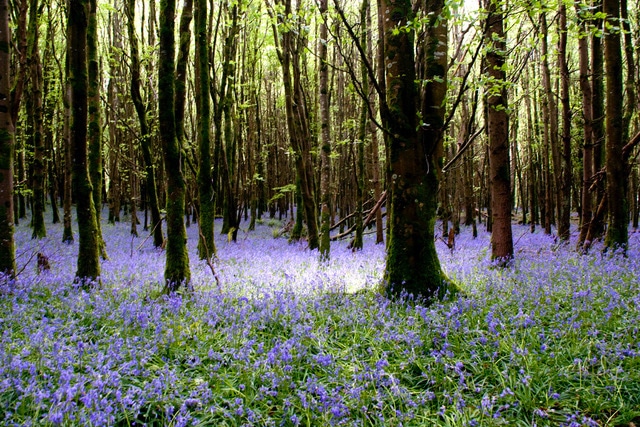
Arts for Climate Justice
Artists, cultural workers and cultural organisations can have a key role to play in contributing to the issue of climate justice. The arts can be used to raise awareness, to inform and inspire, to encourage dialogue and debate and can play a key part in climate change activism. The arts are a unique way to imagine new visions for the future, to explore old ones and to create new spaces for societal change.

An example of an artwork is the brilliant art video by American photographer Camille Seaman ‘The Distant is Imminent’. This is a video projection depicting still and moving images of Arctic and Antarctica that is meant to be projected on walls of cities most threatened by rising sea waters including Limerick in Ireland. It is estimated that 70,000 Irish addresses at risk of coastal flooding by 2050! The following is a link to the artwork : https://fineacts.co/the-distant-is-imminent
By acting on climate change, no matter how big or small, we are taking a stand for nature and our planet and are showing solidarity with all those impacted by this crisis. What is needed is a just transition so that no-one is left behind or overly burdened in the changes needed to protect our planet and future on this earth, as we make change to create a greener more sustainable economy.
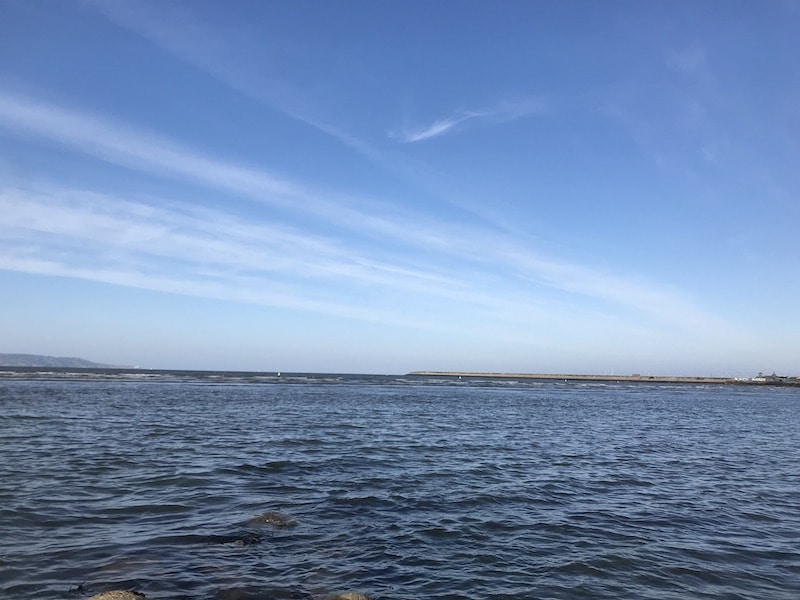
According to Concern Leave No One Behind is one of the cornerstones of the SDGs pledge made by United Nations Member States (including Ireland) to ensure that we work towards achieving the Sustainable Development Goals (also known as the Global Goals https://sdgs. un.org/goals) for the benefit of everyone. The dignity of the individual is fundamental, and the SDGs and targets should be met for all nations and people, and for all segments of society – especially ensuring those who are the furthest behind are included, have a voice, and are supported.

Reference:
- The Carbon Majors Database CDP Carbon Majors Report 2017 ‘100 Fossil Fuel Producers and Nearly 1 Trillion Tonnes of greenhouse gas emissions’, Author Dr Paul Griffn, Climate Accountability Institute
Mary Moynihan, MA
Writer, Director, Theatre and Film Maker
Artistic Director of the Smashing Times International Centre for the Arts and Equality
Connecting Citizens to the Arts, Human Rights, Climate Justice and Gender Equality
www.smashingtimes.ie